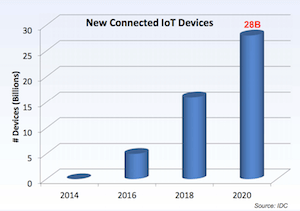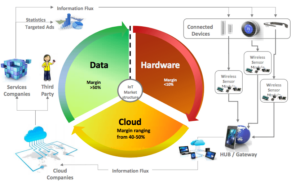 Wait – was that a Klingon I just saw walking through the lobby? Are those two people wearing Star Trek uniforms? By pure coincidence, this year’s 3D Architectures for Semiconductor Integration and Packaging Conference (ASIP 2014), which took place in Burlingame, CA, December 10-12, 2014, overlapped with the 2014 Star Trek Convention. After several days of listening to talks about a future enabled by 3D integration and the Internet of Things (IoT), it was almost surreal to be sharing space with Trekkies in full Star Trek regalia. Just how close are we coming to living in a world similar to the one envisioned by Gene Rodenberry when he first created the series in 1966? According to Samta Bansal,Product Marketing Leader, General Electric, in her inspiring presentation “Will Industrial Internet Drive Next Semiconductor Revolution?” such a future is coming sooner than we think. And while there might not be a transporter involved, a world enabled by the Internet of Things might look something like this:
Wait – was that a Klingon I just saw walking through the lobby? Are those two people wearing Star Trek uniforms? By pure coincidence, this year’s 3D Architectures for Semiconductor Integration and Packaging Conference (ASIP 2014), which took place in Burlingame, CA, December 10-12, 2014, overlapped with the 2014 Star Trek Convention. After several days of listening to talks about a future enabled by 3D integration and the Internet of Things (IoT), it was almost surreal to be sharing space with Trekkies in full Star Trek regalia. Just how close are we coming to living in a world similar to the one envisioned by Gene Rodenberry when he first created the series in 1966? According to Samta Bansal,Product Marketing Leader, General Electric, in her inspiring presentation “Will Industrial Internet Drive Next Semiconductor Revolution?” such a future is coming sooner than we think. And while there might not be a transporter involved, a world enabled by the Internet of Things might look something like this:
If it does, then one thing’s for sure, we’re going to need a lot of Windex. We’re also going to need the integration of software, services and devices that translates, according to Bansal, to the potential for 30% growth in semiconductor revenue by 2020.
In my opinion, although important and interesting, the key takeaways of this year’s 3D ASIP Conference weren’t inspired by the process technology advancements presented by the usual suspects; but by the idea that just maybe, we need to redefine our expectations and goals for 3D integration technologies. Is successful commercialization of 3D realized when we have billions of parts being manufactured at commodity prices that feature 3D TSV interconnects? Or will the success of 3D integration be defined by the opportunities for the future technologies it enables?
In his keynote presentation, Steve Schultz, CEO, Silicon Innovation Initiative (Si2), described how the three “waves” of the Internet have changed the semiconductor industry paradigm. The first wave, the fixed Internet, changed the paradigm of the way we thought about communication. The second wave, the mobile Internet, made it possible to take information along with us. The third wave, the IoT, is a new information revolution. It’s lots more complex, it’s coming, and it’s big, he says.

According to IDC, 28 billion new connected devices will be added to the Internet over the next five years (Figure 1). “That’s greater than a 900X increase from what we’ve had over the past 20 years to get to 3 billion devices,” explained Schultz. “the IoT is economically driving market and paradigm changes, and because of that, its an unstoppable force.” Furthermore, Scultz said the IoT requires a vast variety of integrated technologies that can’t be satisfied by system on chip (SoC) integration, but will require what Schultz calls, system on stack (SoS). It’s not just about integrated circuits. Most IoT applications require a variety of sensors, low power with reduced I/O drivers, and some will need more local processing and/or tight form factors. 3D IC can address all these needs, he says. Essentially, according to Schultz, the IoT is a new growth paradigm for 3D IC. Si2’s goal is to enable this growth paradigm through the development of 3D design standards via its Open3D technical advisory board.
Bansal also encouraged us to “broaden our horizons beyond the iPhone” and consider the potential the industrial IoT offers in sensor development and the critical communications required to run them. She’s talking about applications in critical industrial markets such as biomedical, transportation, and energy. In industrial and commercial markets, there are complex protocols to be met and designed for, she said. “The fixes are more difficult to fix,” she said, citing the example of the $23M cost of recovering damaged equipment from the ocean floor. In these cases, spending $150 on a device to extend the lifetime of the equipment is well worth it for prolonged lifetime security. Bansal shared this video, whic depicts the Industrial Internet opportunities envisioned by GE.
“We went to bed as an industrial company, and will wake up as a big data analytics company,” Bansal noted. By 2020, she said, Gartner predicts that 8+ billion connected things will be shipped in one year, which will require 35B semiconductor devices requiring the fabrication of 6M Si wafers. “That speaks to opportunity for all of us sitting here and that excites me,” she said. Bringing things closer to now, she said that in 2015, data processing will be the largest contributor to semiconductor revenue at $7.58B.
In her presentation, Internet of Things, from Technologies to Market, Rozalia Beica, CTO, Yole Développement echoed the other IoT speakers in describing IoT opportunities, although she was a little more conservative in predicting the time it will take to complete the evolution to the IoT. “It will be slower with less steps than many in the industry are currently forecasting,” she said. Part of this is due to data security, which she says becomes vital issue as malware in the Industrial Internet could trigger direct
physical destruction instead of just affecting sensitive information. Additionally, Beica noted that 75% of all companies across all industries are already exploring opportunities in IoT. For example, service providers such as insurance companies are already offering IoT products.
Beica explained that the IoT structure is divided into hardware, the Cloud and data, and that while hardware can expect less then 10% profit margin for its contributions, those serving the cloud and data markets will realize 40-50% profit margins (Figure 2). As such, she said we can expect more revenue to be generated in the Cloud and data processing sectors, with a total market of $400B with 22% AGR by 2024. This is good news for 3D stacked memories currently entering production for high-end computing, data centers and networking applications. In fact, wearable devices are not the application for 3D ICs at this juncture, but rather data centers where the data is processed will require higher end devices.

In his presentation, which posed the question, Will the Cost of 3D ICs ever be low enough for 3D IC? Chet Palesko, Savansys, pointed out that perhaps this is the wrong question to be asking. Perhaps what we should be asking is will the markets that require 3D packaging grow enough to drive high-volume manufacturing? As performance, bandwidth, power and miniaturization trends continue, 3D ICs could come down enough in cost to enable new market opportunities, he noted.
Jan Vardaman noted in her presentation, The Last Mile: Moving 3D IC into HVM, that memory stacks are in production at low volumes, but have a high dollar value and that makes them legitimate. The question is whether we will see 3D ICs in mobile products, which is where we hit the billion units mark. “There is risk aversion to adopting a new mobile product that has a steep ramp.” She noted.
So maybe smartphones and tablets will never really be the target applications for 3D IC, and maybe that’s ok. Maybe it’s best to leave those devices to what everyone refers to as “alternative to 3D ICs” and focus efforts on low volume products with good profit margins, for which 3D IC is the choice of last resort. “A technology of last resort can still be successful,” noted Palesko. “Flip chip is still a choice of last resort” despite the fact that it has become a mainstream technology. The fact remains, the best packaging choice is the one that meets the product requirements at the lowest cost.
As Mark Scannell ,CEA-Leti, so succinctly put it; “Not all market are consumer driven, 3D opens the door for other technologies.” So lets stop being so hung up on lowering the cost of 3D ICs for HVM in consumer applications, and instead focus on growing the market for devices that can only be enable by 3D. The IoT is coming. Beam me Up, Scotty! ~ F.v.T





















